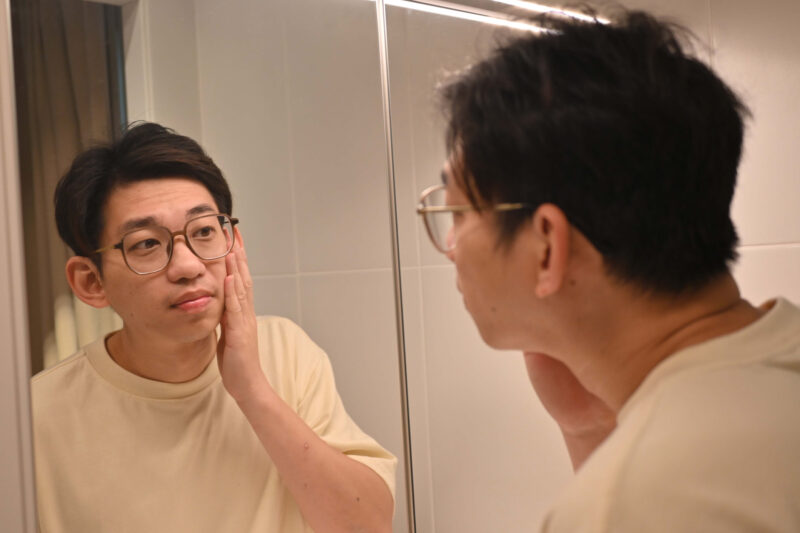
Dysphoria vs. Dysmorphia: What’s the Difference?
6 min.
Feeling uncomfortable about your body can be deeply distressing. Click here to learn the key differences between gender dysphoria (feeling your gender doesn’t match your body) and body dysmorphia (fixating on perceived flaws).
Have you ever felt really uncomfortable or unhappy about your body? It’s a common human experience. But sometimes, these feelings go much deeper, becoming a source of significant distress. When we talk about intense body-related distress, you might hear two similar-sounding words: dysphoria and dysmorphia.
They both describe a kind of upset about one’s body, but the reason for that upset is very different. Understanding this can help you, or someone you know, get the right kind of help and feel understood. Read further to break them down.

Feeling out of sync with your body?
Seeking treatment with Charlie Health can help you find relief and reclaim your confidence.
What is dysphoria?
Think of dysphoria as a deep, persistent feeling of discomfort, distress, or unease. It goes beyond just feeling sad or upset—it’s an intense internal sense that something isn’t quite right, often impacting a person’s overall well-being. Dysphoria can arise from various causes, including mental health conditions like depression or anxiety, or as a reaction to certain life experiences.
What is gender dysphoria?
When we connect dysphoria specifically to the body, we’re usually referring to gender dysphoria—the distress someone feels when their gender identity (their deep sense of being a man, woman, neither, or another identity) doesn’t align with the sex they were assigned at birth (male or female, based on physical characteristics). It’s not just about disliking how you look, like wanting to lose weight or change your hairstyle. Instead, it’s a profound, internal feeling that your body—or certain parts of it—simply doesn’t feel “right” for who you truly are inside.
This feeling comes from a deep sense of self and identity, where the discomfort arises because the body does not match the person’s true gender. For example, a person who knows they are a man might experience distress over having breasts because those body parts don’t align with his internal male identity. This body-related dysphoria can manifest emotionally, physically, or socially, often leading to significant discomfort and a strong desire for their external appearance to reflect their inner gender.
People experiencing gender dysphoria often seek to change their name, pronouns, and appearance or even undergo hormone therapy or surgeries to better align their bodies with their gender identity. This process of aligning one’s body and identity can bring relief and reduce distress, allowing them to live more comfortably and authentically as their true selves.
What is dysmorphia?
Dysmorphia refers to a condition involving a distorted perception or dissatisfaction with one’s body or appearance. The “flaw” might be very minor or even something no one else can see, as it comes from a distorted view of one’s own body. While the term can apply broadly to feeling uncomfortable or unhappy with how you look, in mental health, it’s most often connected to body dysmorphic disorder.
What is body dysmorphic disorder?
Body dysmorphic disorder is a mental health condition where a person becomes deeply obsessed with perceived flaws in their appearance. These “flaws” can be anything — a nose, skin, hair, muscles, or even a small freckle — that the person believes looks ugly or deformed. What makes body dysmorphic disorder particularly challenging is that these flaws are often minor or even invisible to others, but to the person affected, they feel overwhelming and very real.
This distorted perception of their own body leads them to engage in compulsive behaviors, such as constantly checking mirrors, picking at their skin, excessive grooming, or frequently comparing themselves to others. These repetitive actions are attempts to cope with their anxiety and distress but often make things worse. The obsession with these perceived defects causes significant emotional pain and can seriously interfere with daily life, affecting work, school, and relationships. Importantly, this distress is not about feeling that one’s gender does not match one’s body — that is, gender dysphoria — but instead is focused purely on appearance.
Can you have gender dysphoria and body dysmorphia?
Yes, it’s definitely possible to experience both gender dysphoria and body dysmorphic disorder at the same time. For example, someone who is transgender might feel distress because their gender identity doesn’t align with the sex they were assigned at birth—that’s gender dysphoria. At the same time, they might also struggle with body dysmorphic disorder, obsessing over a specific feature like their nose, skin, or hair that isn’t related to their gender identity.
Having both conditions can make things more complicated emotionally and mentally, but it’s important to know that treatment can address each one separately. Mental health professionals will work with the individual to support their gender identity and help reduce the distress linked to dysmorphia, using tailored approaches for both issues to improve overall well-being.
Why does the distinction between dysphoria and dysmorphia matter?
Understanding the difference between dysphoria and dysmorphia is crucial for effective care, validation, and reducing stigma.
- Each condition needs distinct treatment: gender dysphoria requires gender-affirming care, while body dysmorphic disorder (BDD) needs specific mental health therapies.
- Accurate understanding validates the person’s experience, affirming identity in gender dysphoria and recognizing a real mental health struggle in BDD.
- Clear distinctions reduce stigma by normalizing gender diversity and recognizing BDD as a serious condition, encouraging compassion and support.
By recognizing these key differences, we can offer better support and empathy to everyone.
How are these conditions diagnosed and treated?
Both conditions need to be diagnosed by a mental health professional, like a therapist or psychiatrist. They use guidelines from a manual called the Diagnostic and Statistical Manual of Mental Disorders (DSM-5) to figure out what’s going on.
1. Diagnosing and treating gender dysphoria
A doctor will look for a strong and lasting mismatch (at least six months) between your inner gender identity and your birth sex, causing significant distress or problems in your life. They’ll ask if you:
- Feel your body parts don’t match your gender
- Wish to change your body to match your gender or gender identity
- Strongly desire to be the other gender
- Feel you have the feelings and reactions of the other gender
The main goal in the treatment of gender dysphoria is to help you feel comfortable and authentic in your gender. This is called gender-affirming care. It can include living as your true gender in everyday life, like changing your name and pronouns or choosing clothes and a hairstyle that fits you. It may also include medical steps, like taking hormones that can help your body develop features that align more with your gender identity (e.g., facial hair for trans men, softer skin for trans women). Talking to a therapist can also help you explore your feelings about gender, deal with stress, and cope with any other mental health issues you might have.
Diagnosing body dysmorphic disorder
A doctor will look for an intense focus on a perceived flaw in your appearance that seems minor or invisible to others. They’ll also check if you:
- Do repetitive actions (like mirror checking or picking at skin) because of these worries
- Experience significant distress or problems in your life because of these thoughts
- Are not primarily worried about weight or body fat (which would point to an eating disorder)
Treatment for BDD primarily focuses on addressing the distorted thoughts and compulsive behaviors associated with the perceived flaws. Here are some common forms of treatment:
- Talk therapy (CBT/ERP): A specific type of therapy called Cognitive Behavioral Therapy (CBT), especially Exposure and Response Prevention (ERP), can be very effective. It helps you gradually face your fears (like looking in a mirror) without doing your usual checking or hiding routines.
- Medication: Antidepressants, particularly a type called SSRIs, are often prescribed. These can help calm the obsessive thoughts and reduce the urge to do compulsive behaviors.
- Support groups: Connecting with others who have BDD can provide validation, reduce feelings of isolation, and offer practical coping strategies.
- Self-care strategies: Engaging in healthy habits like exercise, mindfulness, journaling, and avoiding alcohol or drugs can complement professional treatment.
How Charlie Health can help
If you or a loved one are struggling with dysphoria or dysmorphia, Charlie Health is here to help. Charlie Health’s Virtual Intensive Outpatient Program (IOP) provides more than once-weekly mental health treatment for dealing with serious mental health conditions, including dysphoria, dysmorphia, childhood trauma, and more. Our expert clinicians incorporate evidence-based therapies into person counseling, family therapy, and group sessions. With treatment, managing your mental health concerns is possible. Fill out the form below or give us a call to start healing today.

